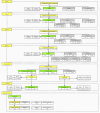Data Collection and Management of mHealth, Wearables, and Internet of Things in Digital Behavioral Health Interventions With the Awesome Data Acquisition Method (ADAM): Development of a Novel Informatics Architecture
- PMID: 39113371
- PMCID: PMC11322796
- DOI: 10.2196/50043
Data Collection and Management of mHealth, Wearables, and Internet of Things in Digital Behavioral Health Interventions With the Awesome Data Acquisition Method (ADAM): Development of a Novel Informatics Architecture
Abstract
The integration of health and activity data from various wearable devices into research studies presents technical and operational challenges. The Awesome Data Acquisition Method (ADAM) is a versatile, web-based system that was designed for integrating data from various sources and managing a large-scale multiphase research study. As a data collecting system, ADAM allows real-time data collection from wearable devices through the device's application programmable interface and the mobile app's adaptive real-time questionnaires. As a clinical trial management system, ADAM integrates clinical trial management processes and efficiently supports recruitment, screening, randomization, data tracking, data reporting, and data analysis during the entire research study process. We used a behavioral weight-loss intervention study (SMARTER trial) as a test case to evaluate the ADAM system. SMARTER was a randomized controlled trial that screened 1741 participants and enrolled 502 adults. As a result, the ADAM system was efficiently and successfully deployed to organize and manage the SMARTER trial. Moreover, with its versatile integration capability, the ADAM system made the necessary switch to fully remote assessments and tracking that are performed seamlessly and promptly when the COVID-19 pandemic ceased in-person contact. The remote-native features afforded by the ADAM system minimized the effects of the COVID-19 lockdown on the SMARTER trial. The success of SMARTER proved the comprehensiveness and efficiency of the ADAM system. Moreover, ADAM was designed to be generalizable and scalable to fit other studies with minimal editing, redevelopment, and customization. The ADAM system can benefit various behavioral interventions and different populations.
Keywords: Fitbit; Internet of Things; IoT; IoT integration; Nokia; behavioral; clinical trial management; data analysis; data collection; device; integrated system; mHealth; mHealth Fitbit; management; mobile health; remote assessment; research study management; study tracking; tracking; wearable; wearable devices.
© I Wayan Pulantara, Yuhan Wang, Lora E Burke, Susan M Sereika, Zhadyra Bizhanova, Jacob K Kariuki, Jessica Cheng, Britney Beatrice, India Loar, Maribel Cedillo, Molly B Conroy, Bambang Parmanto. Originally published in JMIR mHealth and uHealth (https://mhealth.jmir.org).
Conflict of interest statement
Figures







Similar articles
-
Engagement With Daily Symptom Reporting, Passive Smartphone Sensing, and Wearable Device Data Collection During Chemotherapy: Longitudinal Observational Study.JMIR Cancer. 2024 Dec 10;10:e57347. doi: 10.2196/57347. JMIR Cancer. 2024. PMID: 39656513 Free PMC article.
-
A Remote Patient Monitoring System With Feedback Mechanisms Using a Smartwatch: Concept, Implementation, and Evaluation Based on the activeDCM Randomized Controlled Trial.JMIR Mhealth Uhealth. 2024 Nov 22;12:e58441. doi: 10.2196/58441. JMIR Mhealth Uhealth. 2024. PMID: 39365164 Free PMC article. Clinical Trial.
-
Catenation between mHealth application advertisements and cardiovascular diseases: moderation of artificial intelligence (AI)-enabled internet of things, digital divide, and individual trust.BMC Public Health. 2025 Mar 19;25(1):1064. doi: 10.1186/s12889-025-22082-y. BMC Public Health. 2025. PMID: 40108565 Free PMC article.
-
Wearable sensors with possibilities for data exchange: Analyzing status and needs of different actors in mobile health monitoring systems.Int J Med Inform. 2020 Jan;133:104017. doi: 10.1016/j.ijmedinf.2019.104017. Epub 2019 Oct 31. Int J Med Inform. 2020. PMID: 31778885 Review.
-
Smart Home-based IoT for Real-time and Secure Remote Health Monitoring of Triage and Priority System using Body Sensors: Multi-driven Systematic Review.J Med Syst. 2019 Jan 15;43(3):42. doi: 10.1007/s10916-019-1158-z. J Med Syst. 2019. PMID: 30648217
Cited by
-
Adherence to self-monitoring and behavioral goals is associated with improved weight loss in an mHealth randomized-controlled trial.Obesity (Silver Spring). 2025 Mar;33(3):478-489. doi: 10.1002/oby.24234. Epub 2025 Feb 18. Obesity (Silver Spring). 2025. PMID: 39962997 Free PMC article. Clinical Trial.
References
Publication types
MeSH terms
Grants and funding
LinkOut - more resources
Full Text Sources
Medical
Research Materials

